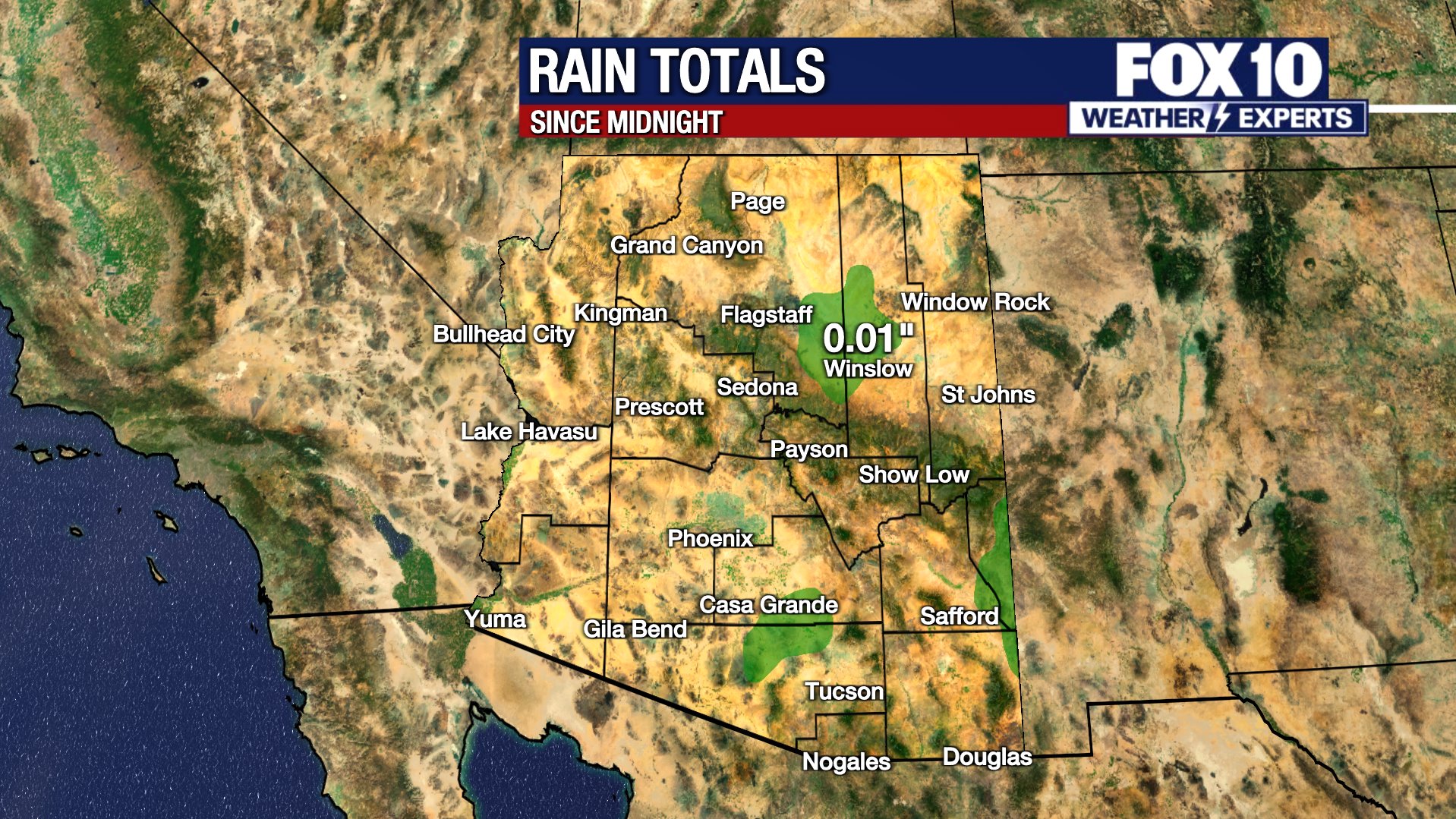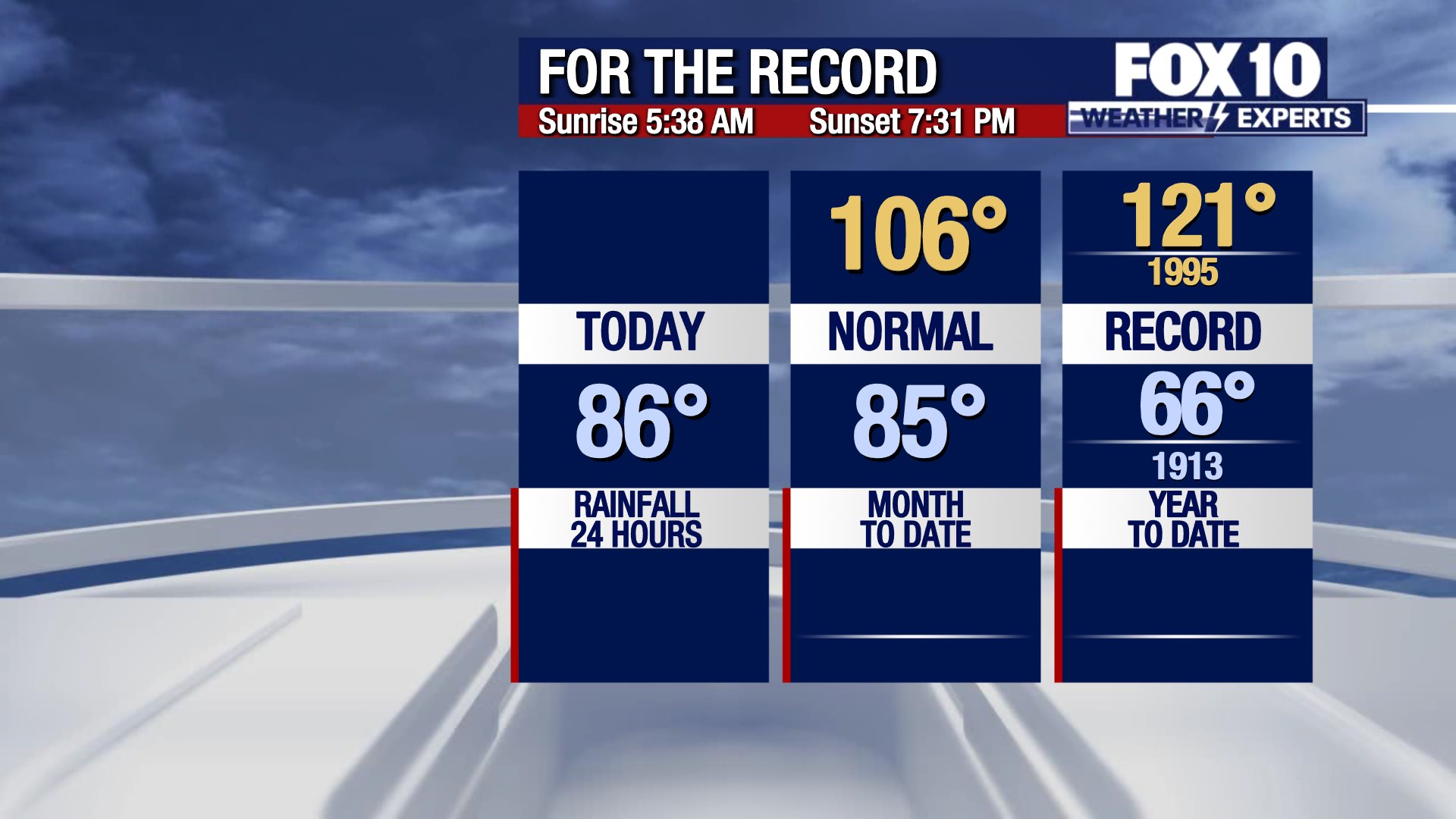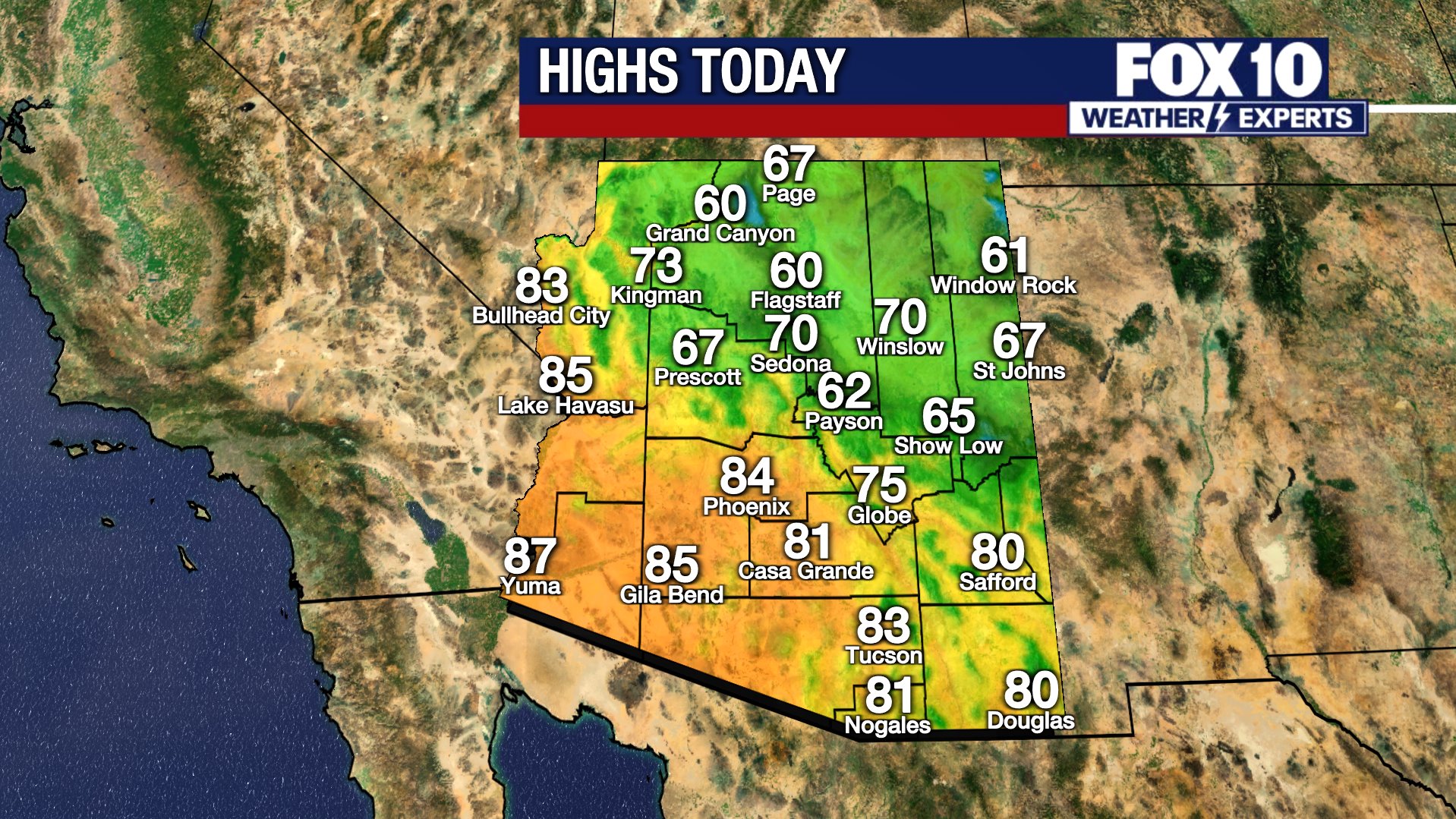Arizona weather forecast: Dust, rain and wind take over parts of the Valley
Temperatures in Phoenix this week are going to be above normal for this time of year. The National Weather Service says temps will continue warming as the week progresses.
The low in Phoenix on Sunday was 89 and the high was 111. Sunday also marked another windy day in the Valley.
NWS says patchy blowing dust is possible in the lower deserts. Isolated rain showers are possible, too.
In northern Arizona, NWS in Flagstaff said on Sunday, "Monsoon activity will be on the low side for much of the coming week as drier air pushes in from the west. Some hope on the horizon, forecast models show high pressure moving northward with a moist south to southeast flow developing toward the end of the week."
Dusty evening in Phoenix
Dust began making its way into the Valley on Sunday night. At one point, FOX 10's camera on South Mountain was blocked by dense dust.
"Blowing dust and storms are moving across the East Valley. NEVER drive into a dust storm," ADOT said on X around 5:50 p.m.
Not long before that, NWS in Phoenix said thunderstorms were impacting parts of Pinal and Gila counties. Much of the storm is expected to miss central Phoenix.

FOX 10's South Mountain camera blocked by a wall of dust on Sunday, July 28 around 6:20 p.m.
You can always check the latest weather conditions by visiting the FOX 10 Phoenix weather page, or download the Free FOX 10 Weather app, which is available on Apple iOS and Android.
Scroll down this page for satellite and radar, day planner, records, current temperatures, 10-day forecast, forecast highs, and recent rainfall totals, plus live video feeds.

The following heat safety information was provided by the Scottsdale Fire Department.
What are Heat Emergencies?
Heat Cramps: Profuse sweating, fatigue, extreme thirst, muscle cramps
Heat Exhaustion: Headache, dizziness, weakness, nausea/vomit, Cool/moist skin
Heat Stroke: Elevated temp. +103 degrees, confusion/irrational behavior, dry/hot skin, rapid shallow breathing, rapid weak pulse (shock), seizures, unconscious
What to do
- Get person into shade or cool location
- Cool person with cool, wet cloths (neck, groin, armpits, head) and fan body
- Sip cool water if person is alert
- For muscle cramps, massage muscles gently, but firmly until relaxed
- *If symptoms worsen, call 911
What not to do
- Do not give anything by mouth if person is vomiting, unable to swallow or unconscious
- Do not underestimate the seriousness of a heat emergency
- Prevention/Preparation for hike/exercise in heat
Know your limitations
- Hydrate (begins day prior to hike/exercise, hour before hike, during and after)
- Wear proper clothing, lightweight and light color, protect head, proper shoes
- Always carry a cell phone and best to hike with company
- Always tell someone where you are hiking and when to plan to return
Preventing heat exhaustion/heat stroke
The Arizona Department of Health Services stated the following precautions can be taken to prevent heat exhaustion or heat stroke:
- Stay in air-conditioned buildings
- Find a cooling center/hydration station
- Limit outdoor activity during the hottest part of the day (mid-day)
- Check on at-risk friends, family, and neighbors at least twice a day
- Drink water before, during, and after working or exercising outside
- Check the UV Index
- Check the heat risk map
Driving in extreme temperatures
The Arizona Department of Transportation’s tips for driving in extreme temperatures include:
Have sun protection: In addition to an umbrella, take sunscreen and a wide-brimmed hat and wear loose-fitting, light-colored cotton clothing.
Fuel up: Keep your tank at three-quarters full. Running out of gas, especially in a remote location, is dangerous in extreme heat.
Hydrate: Take a cooler to keep extra drinking water cold, and consider adding several frozen bottles of water to use for cooling off or to thaw and drink if needed. Make sure everyone, including pets, stays hydrated.
Get help: If your vehicle breaks down in extreme heat, call for assistance right away to reduce wait time, and run the AC. If the AC isn’t working, roll down all windows.
Wait safely: If the temperature inside your vehicle becomes too hot, everyone, including pets, should exit carefully and seek out or create a shaded area as far away from the travel lanes as possible. Be careful walking on the road surface, which can be hot enough to burn skin. Keep your shoes on and try to keep your pets’ paws off the pavement. If you are stopped along the highway, raise the front hood and turn on hazard lights. Please keep in mind that parking in tall brush can start a fire.
Check your vehicle: You can help avoid breakdowns and blowouts by making sure your vehicle is in good operating condition. Check your air conditioner and coolant levels, top off any vital engine fluids and make sure your battery is up to par. Check your tire pressure, as the combination of under inflated tires and hot pavement can lead to a blowout.
Preparing for a severe thunderstorm
The American Red Cross' tips for preparing for a severe thunderstorm:
- Put together an emergency kit.
- Know your community’s evacuation plan.
- Create a household disaster plan and practice it.
- Purchase a battery-powered or hand-crank radio
- Discuss thunderstorm safety with members of your household. Be aware that a thunderstorm could produce flooding.
- Pick a safe place in your home for household members to gather during a thunderstorm. This should be a place where there are no windows, skylights, or glass doors, which could be broken by strong winds or hail and cause damage or injury.
Be prepared and stay safe during the monsoon
"Most Valley residents know how quickly and furiously storms can move in and out, bringing strong winds, dust, rain, and flash flooding. These storms can cause interruptions in services, such as water, power, and gas," stated Captain Ashley Losch of the Glendale Fire Department.
GFD reminds residents of ways they can be prepared and stay safe:
- Have flashlights with extra batteries on hand.
- Have food that can be prepared without the need for cooking or refrigeration.
- Have at least one gallon of clean water for each person in the household.
- Have backup power for anyone requiring power for a medical device.
- Have backup power for cell phones that do not require charging.
- Have a first aid kit ready and accessible.
- Never drive into areas with flowing water; it takes less than 10 inches to wash a car away.
- Avoid flooded areas, such as washes.
- If waters are rising, seek higher ground.
- Do not approach downed power lines, the ground can be energized for up to 200 feet.
- Keep pets indoors during storms.
MORE: https://azdot.gov/about/transportation-safety/severe-weather







